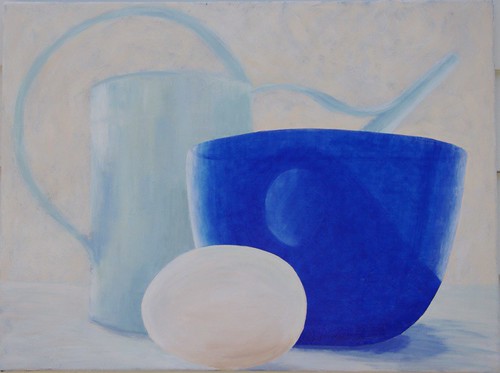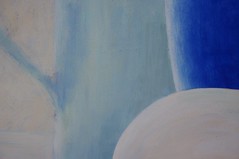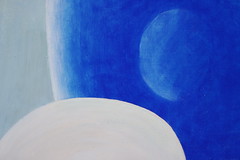
Still Life with Egg
Acrylic on canvas, 18"x24"
2008 Caroline Roberts
Finally I had a productive morning in the studio after so many days being in a virus fog. Just working on grounds and compositions but it was so nice to be back!Something that I am continually trying to capture in my paintings is light. I'm finding that glow of light hard to capture in an abstract painting where I can't rely on the viewer's interpretation as I can in a realistic painting such as the still life above. However, I can try and use the same techniques to produce a glow. In this painting I have two techniques going on that I find interesting:

Detail #1
1. Opaque tints over a dark ground. I actually mixed gesso with acrylic color to produce these tints because I wanted the chalky look it gave me. I could probably get a similar paint if I used titanium white and a little matte medium. Sometimes I really like chalky paint but I do not know whether the gesso and acrylic mix will prove to be totally stable over time.
Detail #2
2. Multiple glazes over a white ground. The egg reflection is lighter because I used less glaze in that area. I love layering glazes but I have trouble getting subtle colors - most of the very transparent acrylic colors are also very saturated. I want colors that are as subtle and varied as the tints I mix with white and that I can layer in glazes without getting dark and muddy.In this painting I have worked both light-to-dark (tints on dark grounds) and dark-to-light (glazes on white). I intend to also try underpainting and then glazing over - something frequently used in the past (in oil paint) but not something I have tried. There is no reason why I cannot use underpainting and glazing in acrylics. I read a fabulous article on the Gamblin website about the difference between classic and contemporary painting: although written for oil painters the description of direct and indirect painting could also apply to acrylic painting. I am fascinated that I can light my paintings from behind by using glazes correctly - I am seeking just that type of glow, the kind that fascinates me in stained glass windows.




No comments:
Post a Comment